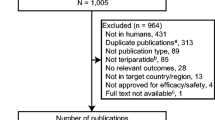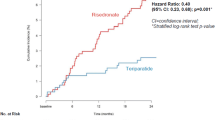Abstract
In the global Fracture Prevention Trial, teriparatide reduced the risk of vertebral and non-vertebral fractures and significantly increased BMD. Recently, a 12-month, phase 3, randomized, multicenter, double-blind, placebo-controlled trial with BMD as a primary endpoint was conducted to assess the effects of teriparatide in Japanese subjects at high risk of fracture. Although BMD was significantly increased in the Japanese study, the study was not statistically powered to assess the anti-fracture efficacy with teriparatide treatment. A meta-analysis was carried out testing whether teriparatide had consistent anti-fracture efficacy in Japanese patients compared to that observed in the global fracture trial. Three studies in which fracture data were available from prospectively scheduled spinal radiographs were included in the analysis. A systematic review of the literature (Medline, Embase) confirmed that no studies with teriparatide had been excluded from this analysis. There was no significant heterogeneity for vertebral and non-vertebral fractures among the studies included in the meta-analysis. Odds ratio estimates (95% CI) were 0.29 (0.20, 0.43) for vertebral fracture and 0.53 (0.32, 0.86) for non-vertebral fracture. There was also a consistent effect of teriparatide to increase BMD across all studies. Furthermore, our analysis demonstrated that teriparatide-mediated increases in spine BMD accounted for 25–32% of the reduction in vertebral fracture risk in the combined population including Caucasian and Japanese patients, which was similar to that derived from Caucasian patients. These results provide evidence for the consistency of anti-fracture efficacy with teriparatide treatment in Japanese patients compared to those observed in Caucasian patients.



Similar content being viewed by others
References
Jiang Y, Zhao JJ, Mitlak BH, Wang O, Genant HK et al (2003) Recombinant human parathyroid hormone (1–34) [teriparatide] improves both cortical and cancellous bone structure. J Bone Miner Res 18:1932–1941
Arlot M, Meunier PJ, Boivin G, Haddock L, Tamayo J et al (2005) Differential effects of teriparatide and alendronate on bone remodeling in postmenopausal women assessed by histomorphometric parameters. J Bone Miner Res 20:1244–1253
McClung MR, San Martin J, Miller PD, Civitelli R, Bandeira F et al (2005) Opposite bone remodeling effects of teriparatide and alendronate in increasing bone mass. Arch Intern Med 165:1762–1768
Neer RM, Arnaud CD, Zanchetta JR, Prince R, Gaich GA et al (2001) Effect of parathyroid hormone (1–34) on fractures and bone mineral density in postmenopausal women with osteoporosis. N Engl J Med 344:1434–1441
Prevrhal S, Krege JH, Chen P, Genant H, Black DM (2009) Teriparatide vertebral fracture risk reduction determined by quantitative and qualitative radiographic assessment. Curr Med Res Opin 25:921–928
Miyauchi A, Matsumoto T, Sugimoto T, Tsujimoto M, Warner MR et al (2010) Effects of teriparatide on bone mineral density and bone turnover markers in Japanese subjects with osteoporosis at high risk of fracture in a 24-month clinical study: 12-month, randomized, placebo-controlled, double-blind and 12-month open-label phases. Bone 47:493–502
Chen P, Miller PD, Delmas PD, Misurski DA, Krege JH (2006) Change in lumbar spine BMD and vertebral fracture risk reduction in teriparatide-treated postmenopausal women with osteoporosis. J Bone Miner Res 21:1785–1790
Saag KG, Shane E, Boonen S, Marin F, Donley DW et al (2007) Teriparatide or alendronate in glucocorticoid-induced osteoporosis. N Engl J Med 357:2028–2039
Nevitt MC, Chen P, Kiel DP, Reginster JY, Dore RK et al (2006) Reduction in the risk of developing back pain persists at least 30 months after discontinuation of teriparatide treatment: a meta-analysis. Osteoporos Int 17:1630–1637
Nevitt MC, Chen P, Dore RK, Reginster JY, Kiel DP et al (2006) Reduced risk of back pain following teriparatide treatment: a meta-analysis. Osteoporos Int 17:273–280
Chen P, Miller PD, Recker R, Resch H, Rana A et al (2007) Increases in BMD correlate with improvements in bone microarchitecture with teriparatide treatment in postmenopausal women with osteoporosis. J Bone Miner Res 22:1173–1180
Matsumoto T, Hagino H, Shiraki M, Fukunaga M, Nakano T et al (2009) Effect of daily oral minodronate on vertebral fractures in Japanese postmenopausal women with established osteoporosis: a randomized placebo-controlled double-blind study. Osteoporos Int 20:1429–1437
Conflict of interest
Dr. Nakamura has served as a consultant for Eli Lilly and Co. M. Tsujimoto, E. Hamaya, H. Sowa, and P. Chen are employees of Eli Lilly Japan K.K.
Author information
Authors and Affiliations
Corresponding author
About this article
Cite this article
Nakamura, T., Tsujimoto, M., Hamaya, E. et al. Consistency of fracture risk reduction in Japanese and Caucasian osteoporosis patients treated with teriparatide: a meta-analysis. J Bone Miner Metab 30, 321–325 (2012). https://doi.org/10.1007/s00774-011-0313-5
Received:
Accepted:
Published:
Issue Date:
DOI: https://doi.org/10.1007/s00774-011-0313-5




